How Are Animals Used In The Ancient Past
Dogs have been a part of the history of human being beings since earlier the written word. The ancient temple of Gobekli-Tepe in Turkey, dated to at least 12,000 years BCE, has provided archaeologists with prove of domesticated dogs in the Middle East corresponding to the primeval evidence of domestication, the Natufian Grave, (c. 12,000 BCE) discovered in Ein Mallaha, Israel, in which an old homo was buried with a puppy.

Roman Guard Dog Mosaic
In southern France, footprints of a young child walking abreast a canine accept been preserved in the earth of the Chauvet Cave, dating to 26,000 years agone and a 2008 CE study concluded that dogs were domesticated in Europe betwixt 32,000-eighteen,800 years ago with the oldest dog remains in the world plant thus far dated to 31,700 years ago (Viegas, one). This Paleolithic dog most resembled a Siberian Husky (Viegas, ane). The findings of the 2008 study are challenged by dog remains establish in the Goyet Caves of Kingdom of belgium which engagement to 36,500 years ago.
Even so old the first canis familiaris was, or how they came to be domesticated, they became friends to humans quite early in history and have remained so. In many cultures throughout the ancient world, dogs figured prominently and, largely, were regarded in much the aforementioned fashion that they are today. Dogs were seen as faithful companions, hunters, guardians, spirit-guides, and as a treasured part of the family unit.
Dogs in Mesopotamia
In the oldest story from the Nearly East, The Ballsy of Gilgamesh from aboriginal Mesopotamia (dated to 2150-1400 BCE), dogs appear in an elevated office equally the companions of one of the most popular goddesses of the region; the goddess Innana (Ishtar) travels with seven prized hunting dogs in collar and ternion. Although Arab republic of egypt is credited with the invention of the dog neckband, it most likely adult in Sumer.
Information technology tin can be causeless the development of the dog neckband was suggested soon after dogs were domesticated which happened in Mesopotamia prior to Egypt. A golden pendant of a canis familiaris (conspicuously a Saluki) was found at the Sumerian city of Uruk dated to 3300 BCE and a cylinder seal from Nineveh (dated c. 3000 BCE) also features a Saluki. The domestic dog pendant wears a broad collar; evidence of the dog collar in use at that time.
In the famous Descent of Innana (a story considered older than and not a part of Gilgamesh) in which the goddess goes down into the underworld, her husband, Dumuzi, keeps domesticated dogs equally role of his royal retinue. Dogs featured prominently in the everyday life of the Mesopotamians. The historian Wolfram von Soden notes this, writing:
The domestic dog (Sumerian name, ur-gi; Semitic name, Kalbu) was one of the earliest domestic animals and served primarily to protect herds and dwellings against enemies. Despite the fact that dogs roamed freely in the cities, the dog in the ancient Orient was at all times mostly bound to a single master and was cared for by him. Of class, the dog was also a carrion eater, and in the villages it provided the same service equally hyenas and jackals. As far as nosotros can tell, there were simply two main breeds of domestic dog: large greyhounds which were used primarily in hunting, and very potent dogs (on the order of Danes and mastiffs), which in the ancient Orient were more than a lucifer for the generally smaller wolves and, for that reason, were particularly suitable as herd dogs. The sources distinguish numerous sub-breeds, but we can only partially identify these. The dog was often the companion of gods of therapeutics. Although the expression `vicious dog' occurred, `dog' as a derogatory term was little used. (91)
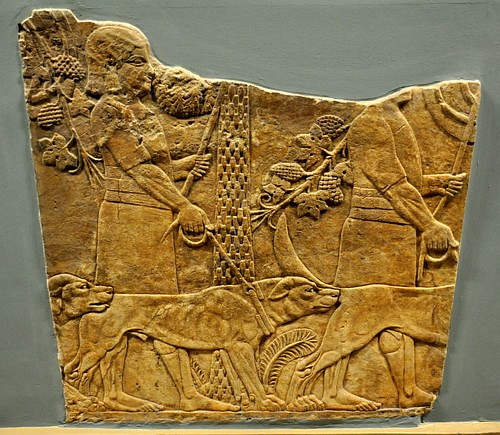
Assyrian Huntsmen with Hounds
Dogs are depicted in Mesopotamian fine art as hunters only besides as companions. Dogs were kept in the home and were treated in much the same manner by caring families every bit they are today. Inscriptions and inlaid plaques depict dogs waiting for their masters and, co-ordinate to the historian Bertman, fifty-fifty listening to their master play music: "The images on inlaid plaques, carved seal-stones, and sculpted reliefs transport us back...We scout a shepherd playing his flute as his dog sits and attentively listens" (294).
Dogs protected the habitation and amuletic images of canines - such as the one mentioned in a higher place from Uruk - were carried for personal protection. The famous Nimrud Dogs, dirt figurines of canines institute at the city of Kalhu, were buried under or beside the threshold of buildings for their protective ability. Five other dog statuettes were recovered from the ruins of Nineveh and inscriptions relate how these figurines were imbued with the power of the dog to protect against danger.
Farther, the "gods of therapeutics" von Soden references above were the deities involved with health and healing and, most notably, the goddess Gula who was regularly depicted in the presence of her dog. Canis familiaris saliva was considered medicinal because it was noted that, when dogs licked their wounds, it promoted healing.
Persian Dogs
Dogs were as well associated with divinity by the ancient Persians. The Avesta (Zoroastrian scriptures) contains a section known as the Vendidad which goes to lengths in describing the beneficial aspects of the dog, how dogs should exist treated, penalties for those who corruption dogs, and how such abuse – or, conversely, care – will touch one's terminal destination in the afterlife. Dogs, in fact, were said to guard the bridge betwixt the world of the living and that of the dead; how ane treated a canis familiaris in ane's life afflicted one's chances of attaining paradise.
People were encouraged to care for dogs just as they would other homo beings.
After death, the soul crossed the Chinvat Bridge where it was judged. If the soul had lived a righteous life in accordance with the precepts of truth, it was rewarded with paradise in the Firm of Vocal; if it had wasted its life in pursuit of self-interest and evil, it was dropped into the hell of the House of Lies. How 1 had treated dogs was a meaning consideration in where the soul would go and killing a dog guaranteed one a place in the House of Lies.
People were encouraged to intendance for dogs just every bit they would other man beings. An injured dog should be nursed back to wellness, a pregnant domestic dog should be cared for as one's own daughter and her puppies looked after for at least six months post-obit birth; afterwards which they should be given good homes. Dogs were provided with funerary rites on par with humans and also played an important part in human being mortuary rituals; they were brought into the room to view the newly deceased, presumably considering of their ability to sense what humans could non, in order to certify that the person was expressionless.
Persian dog breeds included the Saluki, the Sarabi Mastiff, the Alabai (Fundamental Asian Sheepdog), Afghan, and Kurdish Mastiff. They were used in hunting, every bit guard dogs, and for herding sheep only were also kept equally companions. A canis familiaris's soul was thought to exist constituted of one-3rd wild beast, one-third human, and i-third divine and so dogs were to be treated with proper respect and consideration. During daily meals, information technology was stipulated that one should e'er reserve iii morsels of nutrient for one's domestic dog to be given in gratitude for their company.
The Canis familiaris in India
In ancient India the canis familiaris was also highly regarded. The Indian Pariah Dog, which still exists today, is considered by many to be the first truly domesticated canis familiaris in history and the oldest in the world (though this has been challenged). The slap-up cultural epic Mahabharata (circa 400 BCE) significantly features a dog who may have been i of these Pariah Dogs.
The epic relates, toward the cease, the tale of King Yudisthira, many years after the Battle of Kurukshetra, making a pilgrimage to his final resting place. On the mode, he is accompanied by his family and his true-blue dog. One by 1 his family members dice along the path simply his dog remains by his side. When at last Yudisthira reaches the gates of paradise he is welcomed for the adept and noble life he has lived just the guardian at the gate tells him the dog is not allowed within. Yudisthira is shocked that so loyal and noble a creature as his canis familiaris would not exist allowed into sky and so chooses to remain with his dog on world, or even go to hell, rather than enter into a place which would exclude the dog.
The guardian at the gate then tells Yudisthira that this was simply a final examination of his virtue and that, of course, the dog is welcome to enter too. In some versions of this tale, the dog is then revealed to exist the god Vishnu, the preserver, who has been watching over Yudisthira all his life, thus linking the figure of the dog direct to the concept of the divine. This story was used as the plot in an episode chosen "The Hunt" in the famous TV series The Twilight Zone in which a farmer resists the temptations of the devil in the afterlife by refusing to enter "heaven" without his domestic dog. In this episode, as in Mahabharata, dogs are more than than welcome in the true paradise.
Egypt & the Dog
The dog's connectedness with the gods and the domestic dog's loyalty to human beings is further explored in other cultures. In ancient Egypt the domestic dog was linked to the domestic dog-jackal god, Anubis, who guided the soul of the deceased to the Hall of Truth where the soul would exist judged by the swell god Osiris. Domesticated dogs were cached with great ceremony in the temple of Anubis at Saqqara and the thought behind this seemed to be to assistance the deceased dogs pass on easily to the afterlife (known in Arab republic of egypt every bit the Field of Reeds) where they could go along to enjoy their lives as they had on world.
The all-time-known dog interred in this fashion is Abuwtiyuw who was honored with a grand burial in the Former Kingdom (c. 2613-2181 BCE) near the plateau of Giza. Abuwtiyuw was the canis familiaris of an unknown retainer of the king, (whose identity is also unclear) whose limestone memorial slab was discovered in 1935 CE by Egyptologist George Reisner. The inscribed slab would have once been part of the possessor'south memorial chapel and relates how "His Majesty ordered that he [the dog] be buried ceremonially, that he be given a bury from the royal treasury, fine linen in bully quantity, and incense" (Reisner, eight).
Dogs were highly valued in Egypt as part of the family unit &, when a dog would dice, the family unit, if they could afford to, would take the dog mummified.
Although Abuwtiyuw was especially honored, dogs, in general, were highly valued in Egypt as part of the family and, when a dog would dice, the family, if they could afford to, would have the canis familiaris mummified with equally much intendance equally they would pay for a human member of the family.
Great grief was displayed over the death of a dog and the family unit would shave their eyebrows as a sign of this grief (as they as well did with their cats). Tomb paintings of the pharaoh Rameses the Corking draw him with his hunting dogs (presumably in the Field of Reeds) and dogs were oftentimes buried with their masters to provide this kind of companionship in the afterlife. The intimate relationship between dogs and their masters in Egypt is made clear through inscriptions which have been preserved:
We even know many ancient Egyptian dog's names from leather collars also as stelae and reliefs. They included names such equally Dauntless One, Reliable, Good Herdsman, North-Air current, Antelope and even "Useless". Other names come from the canis familiaris's color, such as Blacky, while still other dogs were given numbers for names, such as "the Fifth". Many of the names seem to represent endearment, while others convey but the dog's abilities or capabilities. However, even equally in modern times, there could be negative connotations to dogs due to their nature as servants of homo. Some texts include references to prisoners as `the king's domestic dog'. (TourEgypt.com)
The canis familiaris equally a servant was most conspicuously represented through these collars which would have served to train and control the animals. The earliest bear witness of the dog collar in Arab republic of egypt is a wall painting dated c. 3500 BCE of a homo walking his dog on a leash. The ternion appears to be a simple affair of a rope or material tied to the collar. Egyptian dog collars were manufactured from a single piece of leather stitched and glued to course a ring which then was slipped over the dog's caput.
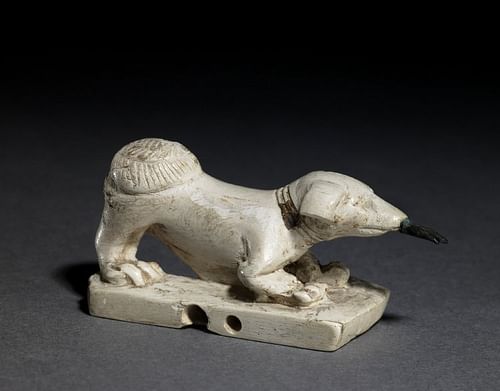
Egyptian Ivory Canis familiaris
From uncomplicated leather rings, the neckband became more elaborate in blueprint by the time of the Heart Kingdom (2040-1782 BCE) when they were ornamented with copper or bronze studs. In the New Kingdom (1570-1069 BCE) they were even more than and so with elaborate etching involved. This is most clearly seen in the dog collar from the tomb of Maiherpri, a noble under the reign of Thutmose Four (1400-1390 BCE) which is a leather band adorned with horses and lotus flowers and dyed a pale pink.
Dogs in Ancient Hellenic republic
Clearly, the dog was an important part of Egyptian gild and culture simply the aforementioned was true of ancient Greece. The dog was companion, protector, and hunter for the Greeks and the spiked collar, so well-known today, was invented past the Greeks to protect the necks of their canine friends from wolves. Dogs appear in Greek literature early on in the figure of the three-headed canis familiaris Cerberus who guarded the gates of Hades.
In the visual arts, the dog is featured on ceramics such as the Caeretan blackness-figure hydria vase of Heracles and Cerberus from c. 530-520 BCE (soon in the Louvre Museum in Paris, France). In Greece, as in ancient Sumeria, the dog was associated with female deities in that both the goddesses Artemis and Hecate kept dogs (Artemis, hunting dogs while Hecate kept black Molossian dogs).
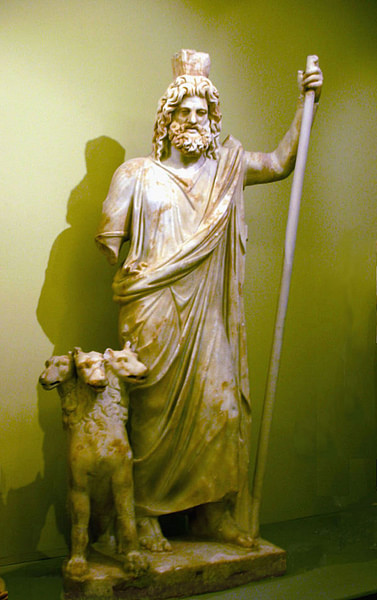
Statue of Hades and Cerberus
The philosophic schoolhouse of Cynicism in ancient Greece takes its name from the Greek for `dog' and those who followed this schoolhouse were called Kynikos (dog-like) in part because of their decision to follow a single path loyally without swerving. The smashing Cynic philosopher Antisthenes taught in a locale known as Cynosarges (the place of the white canis familiaris) and this, perhaps, is another reason for their proper name.
Dogs are also featured in Plato's famous dialogue of Republic. In Book II,376b, Socrates claims that the dog is a true philosopher because dogs "distinguish the face of a friend and of an enemy simply by the criterion of knowing and not knowing" and concludes that dogs must be lovers of learning because they make up one's mind what they like and what they do not based upon cognition of the truth. The dog has learned who is a friend and who is not and, based on that noesis, responds appropriately; while human beings are oftentimes deceived as to who their true friends are.
Probably the about famous dog story from ancient Greece, however, is Argos, the loyal friend of Male monarch Odysseus of Ithaka from Book 17 of Homer's Odyssey (c. 800 BCE). Odysseus comes home later being away for 20 years and, cheers to help from the goddess Athena, is non recognized by the hostile suitors who are trying to win the manus of Odysseus's wife, Penelope. Argos, however, recognizes his master and rises upwardly from where he has been faithfully waiting, wagging his tail in greeting. Odysseus, in disguise, cannot acknowledge the greeting for fear of giving away his truthful identity in front of the suitors and so ignores his old friend and Argos lays back down and dies.
In this story and in Mahabharata, the loyalty of the domestic dog is depicted in the exact same manner. Though separated by unlike cultures and hundreds of years, the dog is depicted as the loyal, devoted friend to his master, whether that master returns the devotion or non.
Dogs in Rome
In ancient Rome, the canis familiaris was seen in much the aforementioned way as in Hellenic republic and the well-known mosaic, Cavern Canem (Beware of Dog) shows how dogs were appreciated in Rome as guardians of the habitation just as they had been in earlier cultures and are still today. The great Latin poet Virgil, wrote, "Never, with dogs on guard, need you fright for your stalls a midnight thief"(Georgics Iii, 404ff) and the writer Varro, in his work on living in the country, says that every family should take 2 types of dog, a hunting dog and a watchdog (De Re Rustica I.21). Dogs protected people non simply from wild animals and thieves but also from supernatural threats.
The goddess Trivia (the Roman version of the Greek Hecate) was the Queen of Ghosts, haunted crossroads and graveyards, and was associated with witchcraft. She stole upon people silently to casualty on them but dogs were ever aware of her first; a domestic dog who seemed to be barking at zilch was thought to be alert one against the approach of Trivia or another disembodied spirit.
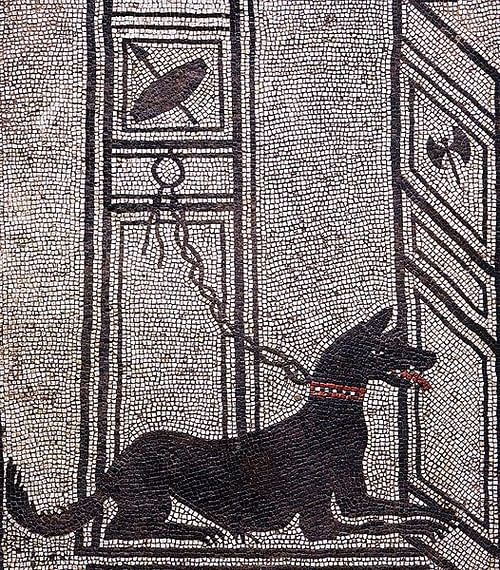
Domestic dog Mosaic
The Romans had many pets, from cats to apes, but favored the domestic dog above all others. The dog is featured in mosaics, paintings, verse and prose. The historian Lazenby writes:
At that place is a large serial of both Greek and Roman reliefs showing men and women with their canine companions. Gallic reliefs peculiarly prove a remarkably human touch in scenes depicting this household favorite with its owners. In these we see charming pictures of salubrious, happy childhood: a male child reclining on a couch and giving his pet dog his plate to lick clean; again, a small-scale daughter, Graccha, who, the inscription tells the states, lived only i year and 4 months, holds in her left hand a handbasket which contains three puppies, the mother of which looks up at them with much business. (ane)
Dogs are mentioned in the Roman law code as guardians of the home and flocks. In i case which was recorded, a farmer brings a conform against his neighbor considering the neighbor's dogs rescued the farmer'south hogs from wolves and the neighbor and so claimed buying of the hogs. The complaint, which was settled in favor of the farmer, reads:
Wolves carried abroad some hogs from my shepherds; the tenant of an adjoining farm, having pursued the wolves with strong and powerful dogs, which he kept for the protection of his flocks, took the hogs away from the wolves, or the dogs compelled them to carelessness them. When my shepherd claimed the hogs, the question arose whether they had get the holding of him who recovered them or whether they were notwithstanding mine, for they had been obtained by a certain kind of hunting. (Nagle, 246)
Varro claimed that no farm should exist without 2 dogs and they should be kept indoors during the twenty-four hour period and let free to roam at night in order to prevent merely such a possibility as the one discussed above. He as well suggested that a white dog should be called over a black one and so that one could distinguish between i's dog and a wolf in the darkness or the twilight of early forenoon.
The Dog in Prc
Aboriginal People's republic of china had an interesting relationship with the domestic dog. Dogs were the earliest animals domesticated in China (c. 12,000 BCE) along with pigs and were used in hunting and kept as companions. They were also used, very early, every bit a food source and equally sacrifices. Ancient oracle basic (which were the basic of animals or shells of turtles used to tell the future) mention dogs repeatedly as both skillful and bad omens depending upon how, in what condition, and under what circumstances, the canis familiaris was seen.
The claret of a dog was an of import component in sealing oaths and swearing allegiances because dogs were thought to have been given to humans as a gift from heaven and so their blood was sacred. Equally a gift from the divine, they were honored but information technology was understood that they had been provided for a purpose: to help human beings survive by providing them with food and with claret for sacrifice.
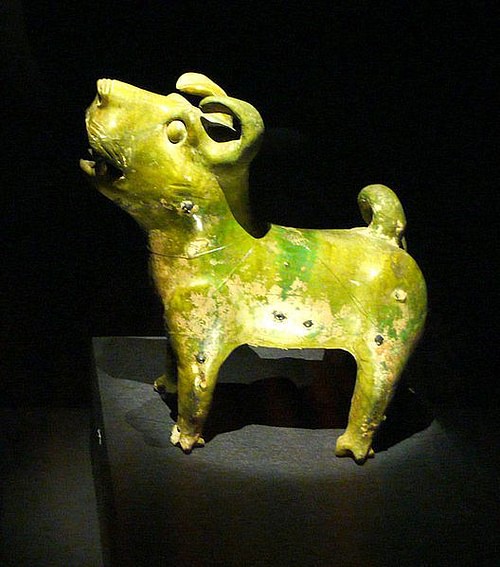
Chinese Ceramic Dog
Dogs were in one case killed and cached in front of a home, or before the urban center'due south gates, to ward off disease or bad luck. In time, harbinger dogs replaced actual dogs equally the practice of sacrificing dogs became less pop. The disease or ill fortune which threatened the city or home was thought to exist as easily deceived by the straw dog figure, thinking it was a guard domestic dog, and would flee as from an actual canis familiaris. The practise of setting a statue or image of a dog in front of 1'due south business firm may come from this custom of burying a straw domestic dog in one's grand for protection against harm.
For personal protection, amulets in the class of dogs were worn. These were frequently made from jade (nephrite) and, during the period of the Liangzhu Culture (c. 3400-2250 BCE) jade dog-amulets were among the most skillfully carved. The prototype above is of a jade dog-amulet belonging to Mr. Alfred Correya which may well be the oldest piece of dog sculpture in the world completely intact. The condition of the piece suggests it was buried equally a grave adept and this is in keeping with ancient Chinese tradition since the canis familiaris was a protective fauna and jade was associated with immortality. A jade domestic dog in a grave would thus both protect and guide the soul in the afterlife.
Dogs in Mesoamerica
The Maya had a similar human relationship with dogs every bit the Chinese. Dogs were bred in pens as a food source, as guardians and pets, and for hunting, but were also associated with the gods. Every bit dogs were noted as slap-up swimmers, they were idea to conduct the souls of the expressionless across the watery expanse to the afterlife, the netherworld of Xibalba. Once the soul had arrived in the dark realm, the dog served every bit a guide to help the deceased through the challenges presented by the Lords of Xibalba and to accomplish paradise.
This has been inferred from excavations in the region which have uncovered graves in which dogs are buried with their masters and from inscriptions on temple walls. Like inscriptions in the surviving Mayan Codices draw the dog as the bringer of fire to the people and, in the Quiche Maya holy book, the Popol Vuh, dogs are instrumental in the destruction of the ungrateful and unknowing race of humans which the gods first produced and then repented of.
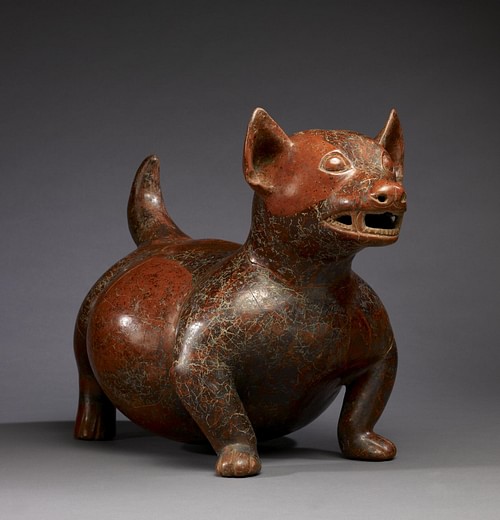
Aztec Domestic dog Effigy
The Aztecs and Tarascans shared this view of the dog, including the dog equally a guide to the afterlife for the deceased. The Aztecs also had a story in their mythology regarding the destruction of an early race of homo beings in which dogs are featured. In this tale, the gods drown the world in a neat alluvion just a human being and adult female manage to survive by clinging to a log. One time the waters recede, they climb onto dry state and build a fire to dry themselves. The smoke from this fire annoys the great god Tezcatlipoca who tears off their heads and and so sews the heads to the rear-ends of the man and woman and, in doing so, creates dogs.
Co-ordinate to this myth, dogs pre-date the present race of human beings and so should be treated with respect the style i would treat an elder. The Aztecs also buried dogs with their dead and their god of death, Xolotl, was imagined as a huge dog.
The Tarascans, like the Aztecs and Maya, kept dogs as pets, for hunting, and for food and besides linked them with the gods and the afterlife. The souls of those who died without proper burying, such every bit those who drowned or were lost in battle or died lone on a hunt, were institute by spirit dogs who would ensure their safe passage to the afterlife.
In all three of these cultures (as, indeed, in the others mentioned above) the belief in ghosts was very real. A ghost could not but make trouble in one'southward daily life simply could actually bring physical harm and fifty-fifty death. The Tarascan tale about the spirit dogs allayed the fearfulness that, if ane had not been able to properly coffin a loved one, the deceased's ghost would render to problem the living. The people would not take to fear because the dog would take intendance of the problem.
Celtic & Norse Dogs
The canis familiaris was also associated with the afterlife, protection, and healing in Celtic and Norse cultures. The Celtic-Germanic goddess of healing and prosperity, Nehalennia, is frequently depicted in the company of a domestic dog and dogs themselves are considered semi-divine (the Celtic goddess Tuirrann was transformed past the jealous fairy queen into the starting time Irish Wolfhound). As in other cultures, the dog was associated with protection afterward death and as a guiding presence.
This was also true in the Scandinavian Norse culture where the canis familiaris Garm was thought to baby-sit the afterlife of Hel, keeping the dead souls in and the living out. Dogs were associated with divinity through the goddess Frigg, Odin's consort, who is oftentimes depicted in a chariot pulled by dogs. Dogs were often buried with their masters every bit protectors and guides in the afterlife and dogs feasted at the feet of their warrior masters in the great hall of Valhalla subsequently death. More dog remains have been found in excavated Norse burying sites than in any other culture.
Conclusion
In ancient India, Mesopotamia, China, Mesoamerica and Egypt, the people had deep ties with their dogs and, as seen, this was also common in ancient Hellenic republic and Rome. Ancient Greeks thought of dogs as geniuses, as `possessing a certain elevated spirit'. Plato referred to the domestic dog as a 'lover of learning' and a 'animate being worthy of wonder.' The philosopher Diogenes of Sinope loved the simplicity of the canis familiaris's life and encouraged human beings to emulate it.
While other animals have undergone significant changes in the fashion they are perceived through history (the cat, virtually notably) the dog has remained a constant companion, friend, and protector and has been portrayed that way through the art and in the writings of many ancient cultures. The onetime claim that a dog is i'southward best friend is substantiated through the historical record simply needs no proof for anyone in the modernistic twenty-four hour period who is lucky enough to enjoy the company of a good dog.
Writer's Notation: This article is dedicated to Sophia the Dog, my own truthful philosopher.
This article has been reviewed for accuracy, reliability and adherence to academic standards prior to publication.
Source: https://www.worldhistory.org/article/184/dogs-in-the-ancient-world/
Posted by: ericksonforkabounce.blogspot.com

0 Response to "How Are Animals Used In The Ancient Past"
Post a Comment